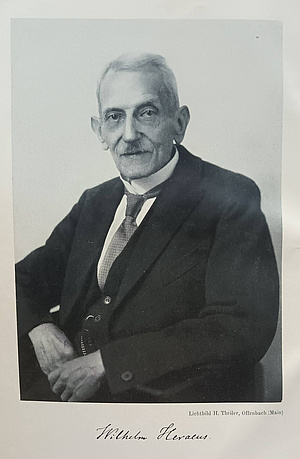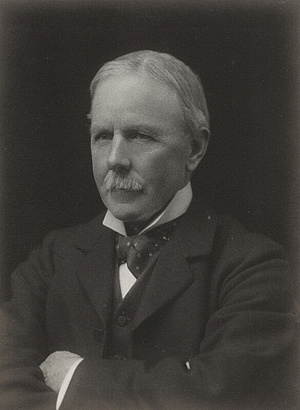About the Corpus Glossariorum Latinorum (CGL)
By Franck Cinato and Adam Gitner
Introduction
The structure and contents of the CGL are outlined in tabular form here and as an Excel spreadsheet here.
The Corpus Glossarium Latinorum (CGL) remains an indispensable and incomparable tool for anyone interested in ancient and medieval glossography and lexicography. Humanists had already recognized the richness and interest of ancient Latin and Greek glossaries by the end of the medieval period, and the work of Vulcanius (Thesaurus utriusque linguae, 1600) already foreshadowed the outline of the Corpus that Goetz eventually gave it.
Started in collaboration with Gustav Loewe, this impressive undertaking was led by Georg Goetz († 1932) alone following the premature death of his colleague at the age of 31 in 1883. However, its completion was possible thanks to many other collaborators, notably Wilhelm Carl Heraeus († 1938), who took charge of the revision and the composition of the Greek word index and the Anglo-Saxon index (with the help of the Germanist Victor K. Th. Michels); Paul Wessner († 1933), who wrote the chapter “De Lindsayi eiusque discipulorum studiis glossographicis” (CGL I:309-392); Gotthold E. Gundermann († 1921) for the edition of the bilingual glossaries; Ernst Stadler († 1913) who revised the medico-botanical glosses; but also the occasional help of Franz Bücheler († 1908) and their students (such as Hans Moeller).
The CGL consists of seven volumes published between 1888 and 1923, including one volume of synthesis (vol. I), four volumes of editions (vol. II–V) and two volumes of index (vol. VI–VII). Each of the four volumes of editions contains material that is varied in terms of typology, but whose coherence has been based either on linguistic characteristics (Latin and/or Greek languages), or in terms of the fields of knowledge covered (philology, medicine), or on chronological considerations. The work was foreshadowed by G. Loeweʼs Prodromus corporis glossariorum Latinorum: Quaestiones de glossariorum Latinorum fontibus et usu (Teubner: Leipzig, 1876), available online here.
1. Synthesis. The first volume, published in 1923 many years after the editions themselves, provides a synthesis covering the complete history of glossography from antiquity and the early Middle Ages until 1923 (see table of contents in volume), despite the fact that the editions published in vols. II to V do not provide all the relevant documents. For this volume deals as much with the history of glossaries (as much as was known at the beginning of the twentieth century) as with glossographers or lexicographers, such as Papias (saec. XI med.), Osbern of Gloucester (saec. XII med.) or Huguccio of Pisa (saec. XII ex.), up to the Summa grammaticalis quae vocatur catholicon (1286), by John of Genoa (or Giovanni Balbi, fl. saec. XIII ex.). The same applies to the biblical glosses and the very numerous collections of collected glosses, of which only a few specimens were delivered at the end of vol. V.
2. Documents. Volumes II to V provide the surviving texts, typically in the form of transcriptions of individual manuscripts with minimal corrections rather than eclectic or reconstructive editions (by contrast, Lindsayʼs Glossaria Latina took a more reconstructive approach to the material). Each of them has a thematic focus: vols. II and III are devoted to bilingual Greek–Latin and Latin–Greek materials (the large, alphabetic bilingual glossaries of Ps.-Philoxenus and Ps.-Cyril, as well as hermeneumata, lists of idiomata and medico-botanical glossaries). Volumes IV and V present the Latin glossaries from the early Middle Ages, which can be characterised as “philological”. Volume IV contains six complete glossaries, while the rest of the volume consists of specimens and extracts; volume V contains a majority of extracts for only four complete glossaries (not including the glossae collectae).
3. Index. Finally volumes VI and VII form the Thesaurus glossarum emendatarum in which all the material published in vols. II to V is presented in alphabetical order and with the incorporation of conjectural emendations that were deliberately not included within the printed texts. This shows the connections and material shared among different parts of the tradition. Volume VII also includes an index of Greek and Anglo-Saxon words.
The CGL, despite its editorial shortcomings and biases, remains an invaluable collection because of its richness and the reliability of the information it contains. It thus remains the starting point for all investigations into ancient and early medieval glossaries.
Further Reading and Research
An essential starting point for understanding the history of these glossaries and the nature of CGL are several studies by A. C. Dionisotti, especially:
- A. C. Dionisotti, “On the Nature and Transmission of the Latin Glossaries,” in Les manuscrits des lexiques et glossaires, de lʼAntiquité tardive à la fin du Moyen Âge: actes du colloque international organisé par le “Ettore Majorana Centre for Scientific Culture” (Erice, 23-30 septembre 1994), 205–252. Turnhout, 1996.
- A. C. Dionisotti, “From Stephanus to Du Cange: Glossary Stories,” Revue dʼHistoire des Textes 14/15 (1984–1985), 303–336.
- A. C. Dionisotti, Expositio notarum (Oxford, 2022).
A very useful overview, especially comparing CGL with Lindsayʼs Glossaria Latina is found in:
- J. E. G. Zetzel, Critics, Compilers, and Commentators: An Introduction to Roman Philology, 200 BCE–800 CE (Oxford, 2018), 233–251.
Few new editions have been published to complement the materials presented in the CGL. W. M. Lindsayʼs Glossaria Latina (1926–1931) provides new editions that are often marred by editorial over-confidence and questionable theories about the origin of the glossaries (see Zetzel), but it does provide the previously unpublished Arma glossary (Glossaria Latina II:1-122). For a partial concordance between the CGL and Glossaria Latina, including newer editions cited by the TLL, please consult the TLL Index Online under the entry “GLOSS.”
The most significant advance since the work of Goetz and Lindsay is the project led by Anne Grondeux (funded by the ERC between 2011 and 2016), which resulted in the first complete edition of the Liber glossarum:
- Anne Grondeux and Franck Cinato (eds.), Liber Glossarum Digital, Paris, 2016 (http://liber-glossarum.huma-num.fr/index.html)
In addition, the online edition of the Epinal-Erfurt glossary (in progress) by Michael W. Herren, David Porter, and Hans Sauer and their team is available at https://doe.utoronto.ca/epinal-erfurt/index.html. Another major contribution has been made by Eleanor Dickey, who has edited, translated, and commented the bilingual colloquia of the Hermeneumata pseudodositheana (Cambridge, 2012–2015; this replaces the texts printed in CGL, but does not include the capitular glossaries).
In conclusion, this collaboration with the Thesaurus linguae Latinae (Bavarian Academy of Arts and Humanities) takes place in the framework of my research at the Laboratoire d'Histoire des Théories Linguistiques (HTL) aiming to complete our knowledge in this field and thus to renovate the history of Latin glossaries of the early Middle Ages (see Thesaurus Glossariorum. The Treasure of glossaries: A History of the Oldest European Latin Glossaries: https://htldb.huma-num.fr/exist/apps/htldb/elma/thegloss/home.html).
F. C.
History of the Annotations
Heraeus Material

Heraeusʼs annotations represent nearly a lifetime of reading Latin glossaries, which he mined for information about late and non-literary Latin. The annotations are found in his personal copy of the CGL volumes, which were donated to the TLL Library along with other annotated books from his private collection (those with lexicographically relevant marginalia include: Mulomedicina Chironis [ed. E. Oder, 1901] and Theodorus Priscianus [ed. V. Rose, 1894], as well as his own editions of e.g. Martial, Petronius, and the Appendix Probi, and many other texts). There is no record of when he acquired the CGL volumes, but we assume that they reached him as they were published and that he continued adding marginalia both while he worked on the indexes and afterwards until his death in 1938 (the published indexes themselves contain extensive marginalia).
After receiving his PhD in Berlin (1885), Heraeus taught as a Gymnasium teacher in Offenbach am Main and as an honorary professor at the University of Frankfurt, where he lectured mainly on Romance philology. He contributed extensively to the TLL (volumes V–VIII) as an author of entries, etymologist, and proofreader, and was consulted as an “oracle” about obscure words. He seems to have advised Goetz generally about the CGL, in addition to the producing the two indexes mentioned above (see Overview). His expertise on late and non-literary Latin are on display in his many publications, especially his editions of the Appendix Probi (Leipzig 1899) and the Peregrinatio Aetheriae (Heidelberg 1908, ²1921, ³1929). Several of his published papers show the value of the glosses for shedding light on obscure passages in sources that range from Petronius to the Edictum Diocletiani. These can be found alongside a full list of his publications in his Kleine Schriften, ed. J. B. Hofmann (Heidelberg 1937), which was financed by popular subscription with special engagement from Einar Löfstedt.
You can find more information about Heraeus in the Neue Deutsche Biography entry and in the Catalogus Philologorum Classicorum entry.
In addition to the Heraeus material at the TLL Library, consisting of about 40 books and a few letters, part of his Nachlass went to the library of the Institut für Klassische Philologie at the Frankfurt Goethe-Universität and to the Frankfurt Goethe-Museum.
Lindsay Material

W. M. Lindsay, a Latinist of prodigious range who was professor at the University of St. Andrews, generously mailed interleaved copies of the CGL Latin index to the TLL Library to support their lexicographic work. The first volume consists of only part of CGL VII, pars prior, containing letters F–N (CGL VII:429–754), but the notes are extremely sporadic until the beginning of H (VII:509). The second volume is CGL VII, pars posterior, pages 1–438, containing the letters O to Z. This has been interleaved and annotated in the same way.
Lindsayʼs annotations on the interleaved pages mainly consist of cross-references to entries in his Glossaria Latina (abbreviated “GLOSS.L” to distinguish from CGL, which he abbreviates “GLOSS.”, as in the TLL) with quotations from the text. Often this overlaps with material already printed in CGL, but sometimes material is included that can only be found, or found in a more accurate form, in Glossaria Latina. Occasionally lemmata and variant spellings are added that were not included in the CGL index. Very rarely corrections and additions are made directly on the printed page.
The only surviving documentation is a letter that Lindsay sent with the second volume, which has been pasted onto the inside front board of the second volume (see scan). This is dated February 12, 1934, Lindsayʼs 76th birthday, and it records the shipment of the O–Z volume. There is no record of when the first volume was sent or why it begins in effect with H. Possibly these volumes represent preparatory work for an index to the Glossaria Latina, which was never completed. But it is also possible that the volumes were prepared specifically at the request of the TLL, which was working on the letter H in the 1930s (however, work was also being done on the letter E; see the publication history here). The ink in the first volume looks slightly lighter and the pages are more yellowed than in the second volume, which suggests some time may have elapsed between them. Lindsayʼs connection to the TLL also included writing the entry galmum (TLL V:1687.69–71) and reading proofs from 1924 onwards.
You can read more about Lindsay in the Dictionary of National Biography entry and in the Catalogus Philologorum Classicorum entry.
Lindsayʼs papers are mainly at the University of St. Andrewʼs Special Collections, with other papers and correspondence at the British Library and the Bodleian Library.
A. G.